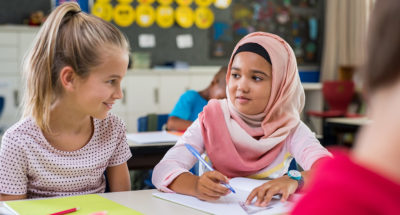
Feelings of Gratitude
Students practice observation skills and identify the emotions related to gratitude.

Students practice observation skills and identify the emotions related to gratitude.
Students will:
While most of the words in the web are likely to express happiness, appreciation, love, etc., it is possible that the visualization may bring up other feelings as well. For example, a student who feels grateful for the kindness of a grandparent who has recently passed away may feel sadness come up while remembering their kindness. If this comes up, be sure to acknowledge the sadness (or fear, worry, or whatever emotion the student might mention), without pushing the student to focus on gratitude instead. It may be a time to introduce the idea that we can feel more than one feeling at the same time. For example, in this scenario, a teacher might say, “I’m so sorry that you lost your grandmother. This must be a very sad time for you. I can see that remembering her brings up sad feelings, as well as all the loving feelings that you are grateful for.”
“Nurturing Gratitude From the Inside Out: 30 Activities for Grades K–8” was originally developed by The Inner Resilience Program, in partnership with the Greater Good Science Center and the John Templeton Foundation.
For the entire curriculum, click here.
Scientists have discovered that emotions serve specific purposes, such as providing information about ourselves, and shaping our relationships with others, in groups, and in society. Indeed, one correlational study with mainly middle class, white undergraduates found that the ability to recognize emotions in another person’s face and voice was related to increased relationship well-being and lower depression.
Providing opportunities for students to practice reading another person’s emotions, whether through facial expression or body language, helps them to develop their social awareness skills, which in turn cultivates healthy relationships—a critical key to building positive classroom and school climates.

Do you want to dive deeper into the science behind our GGIE practices? Enroll in one of our online courses for educators!
Comments